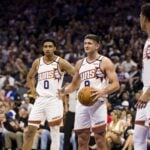
Only 106 players entered the 2025 NBA Draft, per Jonathan Givony. That’s the lowest number of early-entrants since 2015. This is down from a peak of 363 in 2021. That’s the year before the NCAA’s NIL era officially started. This steep decline isn’t random. It’s a direct result of college athletes receiving name, image, and likeness (NIL) compensation. Players now find financial incentives to stay in school rather than chase low-end draft status. This NIL shift has direct consequences for the Milwaukee Bucks and Phoenix Suns.
NIL Will Make Life More Difficult For The Bucks And Suns
Five years ago, prospects jumped to the NBA out of financial necessity. Even when it hurt their long-term development, they left school early. That’s no longer the case. Today, marginal prospects receive NIL deals that match or even exceed the value of late first- or second-round NBA contracts. This shift significantly affects second-apron teams like the Bucks and Suns.
Why NIL Hits Teams Like the Bucks and Suns the Hardest
Both the Bucks and the Suns will rely on hitting on late first-round picks in the near future. These teams traded their picks to build championship contenders.
That’s where the NIL era causes the most damage. For context, the Suns have traded away nearly all of their first-round picks for the next seven years. They still own some picks, but most of their future selections will land in the 20s or later. This is because they are owed picks from contending teams like the Cavaliers or hold the less favorable end of swap agreements
The Bucks face a similar situation. They owe pick swaps to the Pelicans and Trail Blazers from the Jrue Holiday and Damian Lillard trades. These swaps likely place Milwaukee near the end of the draft order for years to come. In this new NIL-driven landscape, the value of those picks continues to decline.
This becomes especially troubling when considering how crucial low-cost, rookie-deal talent is for luxury tax teams like Phoenix and Milwaukee. Teams that spend big on stars need cheap, effective role players from the draft. Without those, they either overspend or fall short in depth.
Late Picks Can’t Compete With NIL Salaries, Hurting the Bucks and Suns
Let’s look at some recent draft salaries to understand why players now hesitate. The 28th pick in the 2024 NBA Draft, Ryan Dunn, earned a four-year deal worth up to $12.99 million with team options in year three and four.
Now consider Tyler Smith, the 33rd pick. His deal is a four-year, $7.89 million deal with a team option in the fourth year. These are solid contracts—but increasingly not enough. High-level college programs now offer NIL deals in that ballpark, or even more, especially for stars and big-market players.
For the Bucks and Suns, who must depend on late draft picks to round out their rotations, NIL complicates everything. Players who once gladly accepted second-round deals now weigh them against million-dollar offers to stay in school. Many opt to return, thinning the draft pool. Dunn appeared in 74 games, starting 44 and averaging 19.1 minutes per game. He was a key contributor for the Suns.
A Thinner Draft Hurts Marginal Teams the Most
Teams that live on the margins—like the Bucks and Suns—feel the sting the most. They lack top-tier picks, so they must unearth gems late in the draft or sign undrafted players who can contribute immediately. But with NIL, fewer of those prospects are even available.
Colorado State’s Nique Clifford offers a perfect example. ESPN’s Jeremy Woo noted that Clifford, despite being out of college eligibility, benefits from a weak draft class. Many late-first and early-second-round prospects might return to school instead. That leaves NBA teams picking from a limited, less-polished pool of talent.
NIL’s Impact Isn’t Temporary
This isn’t a one-year anomaly. NIL changes the draft landscape permanently. As long as college players can earn significant income, they’ll no longer rush to the NBA. While that’s good for athlete autonomy, it places added strain on NBA teams who need to build wisely without top draft assets.
For the Bucks and Suns, that’s a serious problem. They must now scout smarter, develop better, and possibly explore new ways to fill out their rosters. The NIL challenge presented to teams like the Bucks and Suns is real—and unless they adapt, it will only get worse.
© John Hefti-Imagn Images
The post NIL Will Make Life More Difficult For The Bucks And Suns appeared first on Last Word On Basketball.